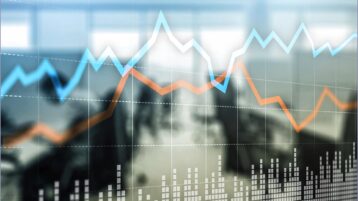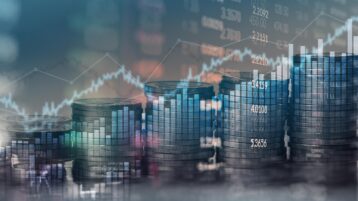The price of gold has been benefiting from falling bond yields as investors focus on potential monetary policy signals from the upcoming Jackson Hole symposium. Greg Barnes, Head of Mining Equity Research at TD Cowen, discusses the implications.
Print Transcript
Gold's getting a boost today, but it is trading still near a five month low. Bond yields, of course, have moved higher over the summer. So what's the outlook for the precious metal and the mining sector as central bankers prepare to meet in Jackson Hole?
Joining us now to discuss, Greg Barnes, Head of Mining Equity Research at TD Cowen. Greg, great to have you back on the program.
Great. Thanks, Greg. Good to be here.
It's a good day to have you on, because I think we're talking about interest rates. We're talking about bond yields and gold. And you can see the relationship. Yields decided to give us a bit of a break today. Gold is popping. Is this pretty much firmly the trade right now in gold?
Yeah. I think it has been, obviously, tied to the 10-year yields. I think they are at 16 or 15-year highs. And I think that's just the market looking at what the Fed's done and what they're likely to do. And I think there was an expectation that maybe the Fed would take its foot off the brake and maybe start to ease at some point.
And that's getting pushed out. And the strong economic numbers out of the US suggest that will be the case. So higher rates is a bit tougher for gold. So we think it'll trade sideways in this kind of environment, maybe slightly down, as it has. But when we get to the point where the Fed starts to ease, that generally is a very good time to be in gold.
Do we need to be-- as investors, if you're interested in gold-- listening pretty carefully to what Jerome Powell is going to have to tell us and Jackson Hole at the end of the week? You dial back to a year ago, he was pretty stern with us. But a lot's happened in a year.
Yeah. Clearly, what he says will have an impact. So you should listen very, very carefully. But I think the message has been higher for longer, and they haven't wavered from that.
So I'm not sure. I'm obviously not an expert on what the Fed is going to say on Friday. But I think that's sort of the message I would expect, anyway, coming out of that.
If we're thinking about a sideways trade, if we are going to be higher for longer, even if they stop, they stick there for a while. When do we expect gold to sort of start moving in a direction that the gold bugs might want to see?
Well, as soon as you get the sense that the Fed is going to start to ease. So you probably don't have to wait for them to actually ease, but when we get to that point where it looks like at some point they will be easing, I think gold will start to respond to that-- so sentiment and just a forward looking view on where the Fed is going.
As we wait for that kind of price movement in the metal itself, what about some of the miners? We've come through another earnings season. How are they faring in this environment?
They're doing fine, I think, is the best way to put it. The first half of the year, I think, across the board, whether you're talking gold or base metals, was tough for various reasons, whether it was just grade related, mining sequence related, some labor issues, some permit issues, things like that, and mechanical issues.
But that was largely expected. Management teams have generally guided to a weak first half and a much stronger second half for most of the companies that we look at. And that story really hasn't varied.
I think we got one guidance cut across the whole group. So the companies are sticking to their message. And on top of that, the cost pressures have eased. They're not coming down dramatically yet, but they're certainly not going up. And in some cases, some of the input costs are going down. Labor pressures have eased. So we should see margins start to expand a little bit in that kind of environment.
When we talk about an eventual movement in gold on signs that the Fed is not only done but might start pulling back on rates, what traditionally leads that kind of space? The precious metal itself, obviously, the miners are very sensitive to it. Do the equities move before or in reaction to the price of gold?
The equities tend to give you a bit of a leading indicator on what's going to happen. I couldn't give you a time frame, but they tend to be a little more reactive.
I was about to write down and say, "on May 11"--
No, they tend to give you a signal when gold is going to move. So I'd watch what the equities are doing. But yeah, gold does tend to lead in that type of environment, much more sensitive. Copper's still sensitive, but gold is more sensitive to rates and the US dollar.
For the challenges that you laid out that we've had in the first half of the year for the mining sector, what does the second half of this year look like?
It looks pretty good, in general, if we believe the guidance that the management teams have given us. Production will lift. A lot of the companies we're talking about, production being weighted roughly 45% to the first half and 55% to the second.
So if that plays out, which we think it largely will, that will help unit costs come down and margins go up. And even in a flat gold price environment, that will look better than the first half of the year, for sure.
What about the M&A activity? Any kind of deal making? At this point in the cycle and what they might be anticipating going forward, would you expect there to be much dealmaking? I mean, there's a few things bouncing around.
Yeah, we've had a few big deals. We've obviously had Newmont buy Newcrest, which is a big deal in the gold space, and a few consolidation moves in the base metal space-- a bit smaller, but still I would think we'll see a similar kind of pace-- some consolidation, some asset purchases, things like that.
When Newmont finally it closes on Newcrest, which will be later this year, there will be assets that they're going to sell. So that will spark a bit of M&A activity, as well. So I think a steady pace of M&A is what we should be looking for.
Would you anticipate a healthy appetite for those assets when they come to the point where they need to sell them? Or will it be a bit of a slog in this environment?
No. I think there will be a reasonably healthy appetite for them from the mid-cap to smaller names, which generally would be interested in those kind of assets.
Apart from what the Fed is going to have to say this week or at their next rate decision next month, we've got some concerns about China.
We do.
World's second largest economy and it just hasn't been able to turn the engines on, despite lifting the COVID restrictions. How concerned do we need to be about that from a commodities and--
That's clearly a concern. And the rolling property crisis, residential property crisis in China clearly isn't helping. I think Country Garden, the biggest private commercial developer or residential developer in China, has run into problems as well, not paying off their debt.
So that is still a lingering concern. I think, to this point, the demand impact on the base metals has generally been offset by EV energy transition demand. Inventories remain very low across the board. So I think that will be supportive. But we do need to see China pick up the pace. There's no question about that.
[MUSIC PLAYING]
Gold's getting a boost today, but it is trading still near a five month low. Bond yields, of course, have moved higher over the summer. So what's the outlook for the precious metal and the mining sector as central bankers prepare to meet in Jackson Hole?
Joining us now to discuss, Greg Barnes, Head of Mining Equity Research at TD Cowen. Greg, great to have you back on the program.
Great. Thanks, Greg. Good to be here.
It's a good day to have you on, because I think we're talking about interest rates. We're talking about bond yields and gold. And you can see the relationship. Yields decided to give us a bit of a break today. Gold is popping. Is this pretty much firmly the trade right now in gold?
Yeah. I think it has been, obviously, tied to the 10-year yields. I think they are at 16 or 15-year highs. And I think that's just the market looking at what the Fed's done and what they're likely to do. And I think there was an expectation that maybe the Fed would take its foot off the brake and maybe start to ease at some point.
And that's getting pushed out. And the strong economic numbers out of the US suggest that will be the case. So higher rates is a bit tougher for gold. So we think it'll trade sideways in this kind of environment, maybe slightly down, as it has. But when we get to the point where the Fed starts to ease, that generally is a very good time to be in gold.
Do we need to be-- as investors, if you're interested in gold-- listening pretty carefully to what Jerome Powell is going to have to tell us and Jackson Hole at the end of the week? You dial back to a year ago, he was pretty stern with us. But a lot's happened in a year.
Yeah. Clearly, what he says will have an impact. So you should listen very, very carefully. But I think the message has been higher for longer, and they haven't wavered from that.
So I'm not sure. I'm obviously not an expert on what the Fed is going to say on Friday. But I think that's sort of the message I would expect, anyway, coming out of that.
If we're thinking about a sideways trade, if we are going to be higher for longer, even if they stop, they stick there for a while. When do we expect gold to sort of start moving in a direction that the gold bugs might want to see?
Well, as soon as you get the sense that the Fed is going to start to ease. So you probably don't have to wait for them to actually ease, but when we get to that point where it looks like at some point they will be easing, I think gold will start to respond to that-- so sentiment and just a forward looking view on where the Fed is going.
As we wait for that kind of price movement in the metal itself, what about some of the miners? We've come through another earnings season. How are they faring in this environment?
They're doing fine, I think, is the best way to put it. The first half of the year, I think, across the board, whether you're talking gold or base metals, was tough for various reasons, whether it was just grade related, mining sequence related, some labor issues, some permit issues, things like that, and mechanical issues.
But that was largely expected. Management teams have generally guided to a weak first half and a much stronger second half for most of the companies that we look at. And that story really hasn't varied.
I think we got one guidance cut across the whole group. So the companies are sticking to their message. And on top of that, the cost pressures have eased. They're not coming down dramatically yet, but they're certainly not going up. And in some cases, some of the input costs are going down. Labor pressures have eased. So we should see margins start to expand a little bit in that kind of environment.
When we talk about an eventual movement in gold on signs that the Fed is not only done but might start pulling back on rates, what traditionally leads that kind of space? The precious metal itself, obviously, the miners are very sensitive to it. Do the equities move before or in reaction to the price of gold?
The equities tend to give you a bit of a leading indicator on what's going to happen. I couldn't give you a time frame, but they tend to be a little more reactive.
I was about to write down and say, "on May 11"--
No, they tend to give you a signal when gold is going to move. So I'd watch what the equities are doing. But yeah, gold does tend to lead in that type of environment, much more sensitive. Copper's still sensitive, but gold is more sensitive to rates and the US dollar.
For the challenges that you laid out that we've had in the first half of the year for the mining sector, what does the second half of this year look like?
It looks pretty good, in general, if we believe the guidance that the management teams have given us. Production will lift. A lot of the companies we're talking about, production being weighted roughly 45% to the first half and 55% to the second.
So if that plays out, which we think it largely will, that will help unit costs come down and margins go up. And even in a flat gold price environment, that will look better than the first half of the year, for sure.
What about the M&A activity? Any kind of deal making? At this point in the cycle and what they might be anticipating going forward, would you expect there to be much dealmaking? I mean, there's a few things bouncing around.
Yeah, we've had a few big deals. We've obviously had Newmont buy Newcrest, which is a big deal in the gold space, and a few consolidation moves in the base metal space-- a bit smaller, but still I would think we'll see a similar kind of pace-- some consolidation, some asset purchases, things like that.
When Newmont finally it closes on Newcrest, which will be later this year, there will be assets that they're going to sell. So that will spark a bit of M&A activity, as well. So I think a steady pace of M&A is what we should be looking for.
Would you anticipate a healthy appetite for those assets when they come to the point where they need to sell them? Or will it be a bit of a slog in this environment?
No. I think there will be a reasonably healthy appetite for them from the mid-cap to smaller names, which generally would be interested in those kind of assets.
Apart from what the Fed is going to have to say this week or at their next rate decision next month, we've got some concerns about China.
We do.
World's second largest economy and it just hasn't been able to turn the engines on, despite lifting the COVID restrictions. How concerned do we need to be about that from a commodities and--
That's clearly a concern. And the rolling property crisis, residential property crisis in China clearly isn't helping. I think Country Garden, the biggest private commercial developer or residential developer in China, has run into problems as well, not paying off their debt.
So that is still a lingering concern. I think, to this point, the demand impact on the base metals has generally been offset by EV energy transition demand. Inventories remain very low across the board. So I think that will be supportive. But we do need to see China pick up the pace. There's no question about that.
[MUSIC PLAYING]



























